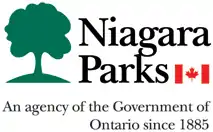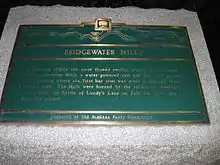Niagara Parks Commission
The Niagara Parks Commission (French: Commission des parcs du Niagara), commonly shortened to Niagara Parks, is an agency of the Government of Ontario which maintains the Ontario shoreline of the Niagara River.
| Commission des parcs du Niagara | |
 | |
| Agency overview | |
|---|---|
| Formed | 1885 |
| Jurisdiction | Government of Ontario |
| Headquarters | Oak Hall 7400 Portage Road Niagara Falls, Ontario |
| Minister responsible |
|
| Agency executive |
|
| Child agency | |
| Key document |
|
| Website | www |


History
The Commission was founded in 1885 and charged with preserving and enhancing the natural beauty of Niagara Falls and the Niagara River corridor as a public greenspace and environmental heritage.[1] The first commissioner was Casimir Gzowski. Other notable Commissioners have included Thomas McQuesten and James Allan. Current Commission Chair is Sandie Bellows, who was appointed in 2019.
Activity
In total, the Commission is in charge of about 16.19 square kilometres (6.25 sq mi) of parkland along the river, in addition to the Niagara Parkway which spans 56 kilometres (35 mi). In this corridor, the NPC manages numerous trails, historic sites, picnic areas, and attractions. The Commission formerly managed Navy Island National Historic Site under a lease agreement with the Parks Canada.
Niagara Parks also operated the People Mover, a shuttle bus system intended to aid transportation along the Niagara River and help reduce automobile crowding near the Falls. The buses were powered by propane and included a trailer unit during most popular hours. In the long term, the Commission is planning for a fixed track transit system along the Niagara Parkway, although no decision has been taken on the exact technology to be used.[2][3] In the meantime, the Commission joined forces with Niagara Falls Transit to launch the fully accessible WEGO bus system in 2012, and in the process discontinued the People Mover service.[4]
Sites and attractions managed by the Commission
- Chippawa Battlefield Park: site of the Battle of Chippawa in the War of 1812 and a National Historic Site
- Dufferin Islands
- Falls Incline Railway: funicular railway connecting Table Rock Welcome Centre to the hotels in the Fallsview Tourist Area
- Hornblower Niagara Cruises: boat trips along the Niagara River to the Bridal Veil and Horseshoe Falls (formerly operated by Maid of the Mist), operated under contract by Hornblower Cruises
- Laura Secord Homestead: historic home of Laura Secord, a heroine of the War of 1812, and a National Historic Site
- Mackenzie Printery: printing museum located in the home of historic politician and journalist William Lyon Mackenzie, leader of the Upper Canada Rebellion
- McFarland House
- Niagara Glen Nature Reserve
- Niagara Parks School of Horticulture: a world-renowned training centre for horticulturalists and gardeners
- Oak Hall: historic home of mining tycoon Harry Oakes, now partially open as a museum and partially used for NPC offices
- Old Fort Erie: historic British fort and a National Historic Site
- Queen Victoria Park
- Queenston Floral Clock
- Table Rock Welcome Centre: visitor's centre in Niagara Falls with observation decks, restaurants, and shopping areas
- Journey Behind the Falls: tourist attraction consisting of tunnels and observation platforms adjacent to and behind the Horseshoe Falls
- Whirlpool Aero Car: a scenic cable car ride which crosses over the Niagara Whirlpool
Niagara Heritage Trail
The Niagara Heritage Trail is a historic and scenic route running the entire 35 mile Canadian coastline of the Niagara River from Fort Erie northward to Niagara-on-the-Lake. Construction began in stages during the early 1980s, and was completed in 1995.
The trail makes its central heart in Queen Victoria Park near the main tourist area, and also passes by attractions such as the Whirlpool Golf Course, Niagara Botanical Gardens, the Butterfly Conservatory, and the Floral clock.
Aims and objectives
The aims and objectives of The Niagara Parks Commission as set out in The R. Strong & Associates Report, 1969, are as follows:
- To maintain, preserve and enhance the beauty and surroundings of the Canadian Horseshoe Falls and the Niagara River, from Fort Erie to Niagara-on-the-Lake, while maintaining financial self-sufficiency;
- To develop, operate and maintain a system of parks and recreation areas, historic sites and educational facilities which complement the natural wonders of Niagara Falls and the Niagara River, and which will facilitate and add to the visitor’s enjoyment;
- To provide those wishing to view and enjoy the splendor of Niagara Falls an opportunity to do so with ease;
- To provide a broad range of educational opportunities in the fields of horticulture, geology, natural history and the history of the Niagara Frontier;
- To continually seek new methods and means for improving the visitor’s experience when visiting the Falls area;
- To encourage complementary uses of land adjacent to the Parks system and to work with other groups and agencies who have compatible interests in the Park area.
- To ensure a suitable first and last impression for the many millions of foreign visitors to Ontario and to Canada crossing the borders along the Niagara Frontier;
- To encourage and promote the development of the tourism industry in Ontario and Canada; and
- To pursue the self-sustaining nature of the Parks System while recognizing the limitations of compatible and suitable revenue-producing facilities and the long-range need for capital improvements.
See also
- List of botanical gardens in Canada
- Alfred H. Savage - Sarnia born horticulturalist and transit manager, School of Horticulture graduate 1952
- William "Red" Hill Sr., life saving hero; in 2018, the Commission installed a commemorative display of his heroic work in 1918 during the Niagara Scow incident
References
- "Niagara Parks Attractions". Clifton Hill Resorts. Retrieved 2010-07-23.
- "People Mover Buses". Niagara Parks Commission. Archived from the original on April 1, 2007. Retrieved March 30, 2007.
- "The Review - Remember the people mover?". Osprey Media. Retrieved March 30, 2007.
- Langley, Alison. "New tourism buses stall". Niagara Falls Review. Archived from the original on 3 March 2016. Retrieved 2 May 2013.
.svg.png.webp)